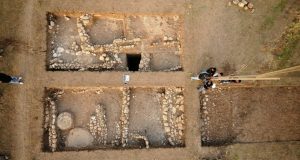Researchers working at Boncuklu Tarla (Zeviya Maherk) site, South-East Turkey, revealed information about the burial traditions of people living there during the Pre-Pottery Neolithic period around 10000-7000 BC.

The site was discovered in 2008 during a field survey carried out in connection to the Ilısı Dam project – the construction of a dam on the Ilısı river. The excavations unearthed remains of a settlement build on rubble stones with hardened clay floors, dating back to between 10000-7000 BC. Archaeologists also discovered traces of first agricultural activities in the Anatolian region and were able to shed some light on the views of the afterlife as well as the burial traditions of the site’s inhabitants. the dead were buried in graves under the floors of the houses with a foetal position, suggesting that there was a belief in rebirth. The dead were also buried with ornaments made of beads and ground stone tools. Archaeologists believe that the excavations showed that the tradition to use ornaments in order to seek protection from illnesses dates back to 10000 years. Along with thousands of beads used as ornaments, obsidian or flint blades, waste from ornament making and stone chipping tools were found at the site. The tools include blades, gimlets, arrowheads and microliths.

(after Daily Sabah)